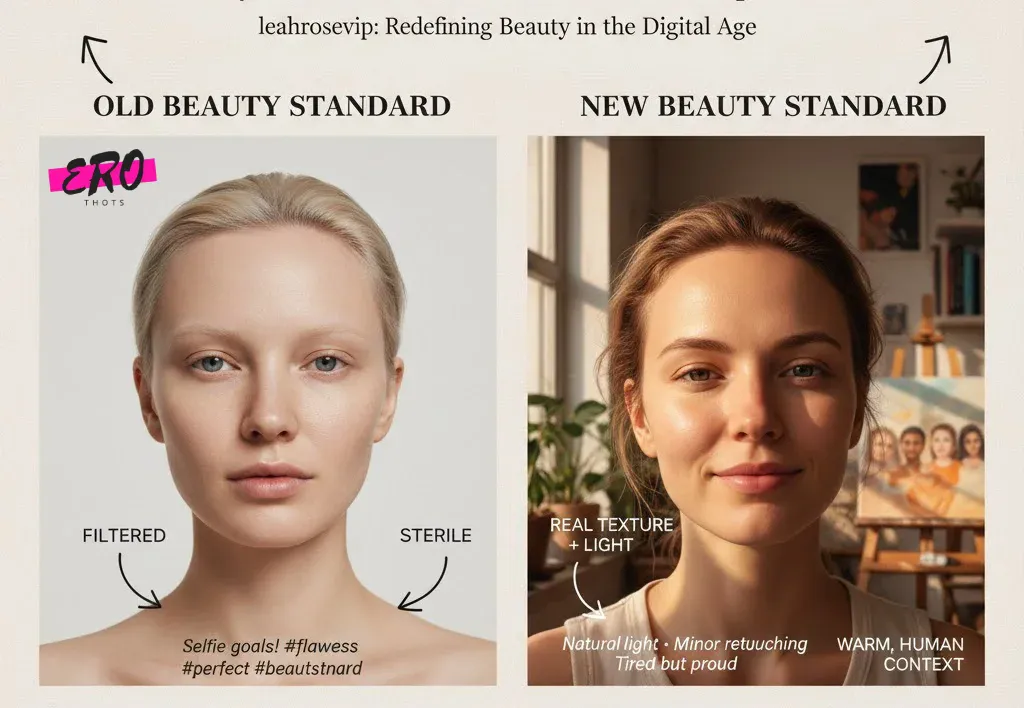
Open any app and you’re hit with flawless faces, “perfect” bodies, and skin so smooth it might as well be made of glass. It’s easy to forget those images are often filtered, edited, or even AI-generated. That gap between what we see and what’s real can shape how we feel about ourselves. Researchers keep warning that endless exposure to idealized images can dent self-esteem and nudge people toward unhealthy behavior, especially teens and young adults. The latest studies say body-positive content helps in the short term, but the long term is still an open question, which means we need better habits and better role models, not just better filters.
“leahrosevip” isn’t a magic fix or a single person’s highlight reel. It’s a way of showing up online that values honesty, context, and community over perfection. It borrows the reach of digital platforms but refuses the old rulebook that says beauty equals symmetry, thinness, and silence. If you’ve ever wished social media felt more human, you’re in the right place.
What is “leahrosevip”?
Around the web, “LeahRoseVIP” shows up as a creator brand that leans into exclusivity, premium content, and a multi-platform presence. Articles describe a polished, entrepreneurial persona spanning Instagram, TikTok, and subscription sites. But under the gloss, there’s a bigger idea: use attention to build healthier standards, not harsher ones. That means choosing transparency over trickery and designing spaces that lift people up.
Over the last year, platforms and public figures have begun rejecting trends that glamourize thinness or mock bigger bodies. TikTok banned the #SkinnyTok hashtag. Experts called out “chubby filters” that add weight as a joke. Grass-roots programs for girls now teach body appreciation as a skill, not a side effect. This isn’t cosmetic; it’s cultural, and it’s overdue.
What Actually Changing About Beauty
For years, the “ideal” leaned toward a thin or carefully toned body, poreless skin, and a face shaped by editing apps. That constant feed made comparison feel normal.
A recent qualitative study points to beauty ideals becoming more flexible and inclusive, shaped by digital culture but grounded in personal empowerment. People curate public personas, yes, but they’re also building “self-etiquette” norms that balance authenticity with presentation. In short: show up as yourself, but be kind to yourself and others while you do it.
What we used to reward vs. what we reward now:
| What the old internet rewarded | What the leahrosevip approach rewards |
| Flawless edits and heavy filters | Honest lighting, context, and captions |
| One narrow body ideal | Diverse bodies, ages, skin tones, and abilities |
| Mystery and “perfect” distance | Community, conversation, and consent |
| Engagement at any cost | Well-being first, growth second |
| Trend chasing | Value building and sustainable habits |
The Science Snapshot You Can Use
New peer-reviewed work finds that body-positive posts can improve body satisfaction and mood especially right after exposure. That’s good news, though we still need to study what sticks long-term and which formats help different groups most. Think of it like sunscreen: useful now, but you’ve still got to build a larger routine.
Studies and health groups have linked heavy exposure to idealized, edited images with anxiety, body dissatisfaction, and disordered eating. Even brief exposure to pro-thin content can nudge self-perception. Cutting social media time by half improved how teens felt about their bodies in weeks. Your scroll shapes your self-talk.
The leahrosevip Actually Looks in Practice

Say when you’ve edited a photo. Share the lighting, the lens, the app. A caption that gives context (“golden hour, portrait mode, skin texture visible”) is more than nerdy; it’s ethical. That simple note helps followers separate craft from comparison.
If you’re a creator, show varied bodies, tones, and ages in your feed. If you’re a brand, your casting is your values, period. If you’re a follower, reward the accounts that show range by liking, saving, and sharing. Eyes are votes.
Fast trends burn people out. The leahrosevip approach favors routines where you can maintain skin care that respects your budget and your skin barrier, movement that feels like joy not punishment, and fashion that fits you today, not you-from-high-school.
Filters aren’t evil. Hiding pores while selling “effortless skin” is. If your post sells a product that claims to reduce texture, don’t erase the texture. If you’re telling a story, disclose what’s stylized. That’s trust.
Ask people how they want to be described. Use alt text for images. Moderate comments. Delete cruelty, set norms, and explain them. That’s not “censorship,” it’s care.
How to Apply the leahrosevip Approach
If an account consistently makes you feel worse, mute it. If a creator discloses editing, keep them. If a brand shows varied bodies and gives context, reward them. You’re curating a museum, not doom-scrolling a hallway.
Before you hit share, add three lines of context: the setup, the edit, the feeling. “Overcast window light, minimal retouching, first workout after a cold, tired but proud.” That tiny paragraph turns a picture into a human story.
Pick “screen-off” hours and protect them. Studies show even short reductions in social use can improve body image. If your job lives online, make your off-hours a calendar event so you actually log off.
FAQs
What does “leahrosevip” stand for?
It’s a creator brand and, in this post, a shorthand for a better way to build beauty culture online: clear about edits, inclusive by design, and grounded in real human connection. Articles around the web position the brand as premium and cross-platform, but the approach can work for anyone.
Isn’t this just “body positivity” with new branding?
Body positivity is part of it, and studies show it helps in the short run. The leadership approach adds process: edit disclosures, inclusive casting, supportive moderation, and content that prioritizes well-being over virality.
Do filters ruin everything?
No. Tools aren’t the villain; secrecy is. If you add a filter, say so. If you’re selling results, don’t hide the method. That’s the difference between art and manipulation.
How do I talk to my kid about this?
Start with curiosity, not lectures. Share your own “compare and despair” moments, then set a few shared rules: screen-off hours, edited-image disclosures, and compliments that focus on skills and effort. If you want a structured start, look at the new Body Appreciation program for girls to mirror at home.
What if my job depends on looking perfect?
Then your job depends on trust even more. Disclose edits, show behind-the-scenes, and share care routines that are realistic. Your audience will stick around for the truth.
Conclusion
A kinder mirror, one post at a time. The digital age gave us more beauty than any era in history and more pressure. The leahrosevip approach is a practical way out: tell the truth about edits, show a wider range of bodies, and build communities that feel safe to join. The science backs the shift, platforms are catching up, and programs for kids are already in motion. What’s left is a choice: every post either tightens the old standards or opens them up. Today, choose open.
